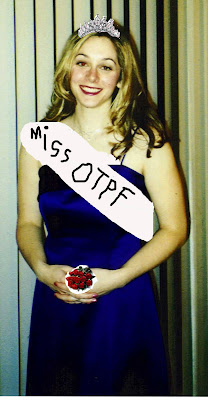They call me…Miss OTPF.
Karen would like to thank her adoring OT fans for their support as she ran for the competitive title of Miss OTPF 2007. She promises to take her role seriously and will spread the power of the OTPF throughout the nation, seeing as how she has not only memorized it, but keeps copies of it in her bag at all times.
UPDATED JANUARY 2014: Click here for a OTPF-3 cheatsheet
I made a one-page Word document OTPF summary sheet for my classmates, which I am copy/pasting here.I hope it is helpful to incoming MOT students, as you will live and breathe this OTPF so you might as well get used to it. (I edited this version slightly, so you may need to do some formatting to fit it on the one page.)
The scoop: All your professors will want you to be familiar with the OTPF (an AOTA official document) and have it serve as a guideline for treatment. Other documents that all OT students should be aware of are listed on AOTA’s website under the Student Section.
The Occupational Therapy Practice Framework (OTPF)
Basic Summary: The OT field wanted to make sure there was an official, AOTA-driven document that focused on articulating OT’s “unique” focus on occupation and activities of daily life. It also explains an intervention process used by OTs to facilitate patients, using engagement in occupation as the focus.
How it works: Use a top-down (deductive) approach where you look at the person holistically, then break the issues down using the categories below. The first step (evaluation) includes an “occupational profile”, during which you will learn as much as possible about the meaningful activities of the patient. You then use this information to guide your second step of intervention. Ideally, you will be successful, which will be determined in examining the outcome (third and final step).
Performance in Areas of Occupation (life activities people engage in): Seven areas:
- Activities of Daily Living (ADL) – (bathing/showering, bowel and bladder management, dressing, eating, feeding, functional mobility, personal device care, personal hygiene and grooming, sexual activity, sleep/rest, and toilet hygiene.)
- Instrumental Activities of Daily Living (IADL) (care of others, pets, child rearing, communication device use, community mobility, financial management, health management and maintenance, home establishment/management, meal preparation/cleanup, safety procedures and emergency responses, and shopping)
- Education, Work, Play, Leisure, and Social Participation
Performance Skills (focus on what the person does, looking at observable action that has a functional purpose): Three areas:
- Motor Skills (posture, mobility, coordination, strength/effort, energy)
- Process Skills (energy, knowledge, temporal organization, adaptation, organizing space)
- Communication/Interaction Skills (Physicality, Information Exchange, Relations)
Performance patterns (Behaviors related to activities of daily life): Three areas:
- Habits (Useful habits, impoverished habits, dominating habits)
- Routines & Roles
Context (environmental conditions that may affect client’s performance) Seven areas:
- Cultural, physical, social, personal, spiritual, temporal, virtual
Activity Demands (what an activity requires for it to be doable): Seven areas:
- Objects Used and their Properties, Space Demands, Social Demands, Sequencing and Timing, Required Actions, Required Body Functions and Required Body Structures
Client Factors (body/brain issues that can affect client’s occupational performance)
- Body Functions (mental functions, sensory functions and pain, neuromusculoskeletal and movement-related functions, cardiovascular/hematological/immunological/respiratory system function, Voice and Speech functions, Digestive, metabolic, endocrine, genitourinary and reproductive functions, skin and related structure functions.)
- Body Structures (Structures of the nervous system, eye, ear, voice, speech, all body systems noted in body functions above, structures related to movement, skin and related structures.)
Intervention Approaches
- Create, promote – does not assume disability. Provide experiences 2 enhance performance for all.
- Establish, restore – establish skill/ability not yet developed, or restore one that was impaired.
- Maintain – provide supports to allow clients to preserve performance capability
- Modify (compensation, adaptation) – finding ways to revise current context/activity demands to support performance in natural setting
- Prevent – for clients with or without disability who are at risk for occupational performance problems.
Reference: American Occupational Therapy Association. (2002). Occupational therapy practice framework: Domain and process. American Journal of Occupational Therapy, 56, 609-639.
Update: dude who left me a snarky comment – you may be correct from a historical standpoint, but what I put up was paraphrased from the book – so….don’t be mean.


